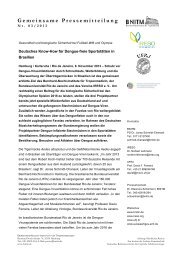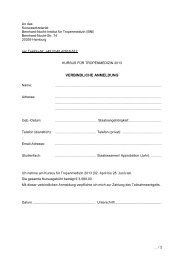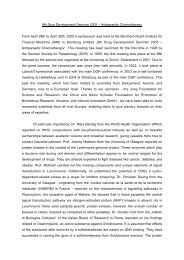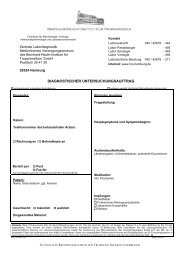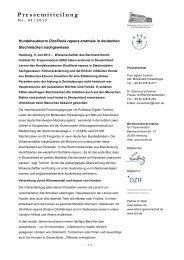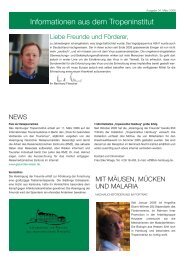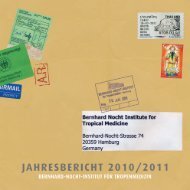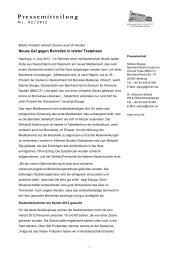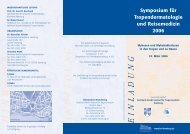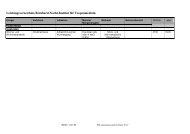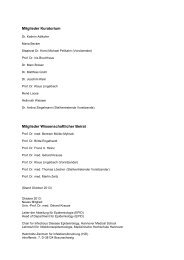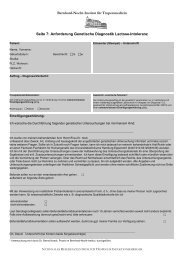Research Group Heussler (Malaria I) - Bernhard-Nocht-Institut für ...
Research Group Heussler (Malaria I) - Bernhard-Nocht-Institut für ...
Research Group Heussler (Malaria I) - Bernhard-Nocht-Institut für ...
Create successful ePaper yourself
Turn your PDF publications into a flip-book with our unique Google optimized e-Paper software.
our 10 to 100 fold more parasites within various organs<br />
such as heart muscle or the spleen. IL-12 is expressed<br />
by activated macrophages and augments the<br />
generation of Th1 cells, the production of IFN-γ and the<br />
activation of NK cells. IL-18 has been shown to augment<br />
IFN-γ expression and NK cell activation in the presence<br />
of IL-12. We used C57BL/6 mice deficient of IL-<br />
12p40 or of IL-18 to determine differential requirements<br />
for these Th1 inducing cytokines in the implementation<br />
of a protective immune response. We analysed trypanocidal<br />
effector functions of NK cells and their contribution<br />
to innate resistance to the parasite.<br />
Project Description and Results<br />
IL-12-/- mice were highly susceptible to T.cruzi infection<br />
and succumbed to low infective doses, displaying high<br />
parasitemia and tissue parasite burdens on day 14 of<br />
infection (fig. 1). IL-18-/- mice were found to resist low<br />
infective doses to the same extent as wildtype mice.<br />
Tissue burdens were not significantly increased in<br />
these mice. IFN-γ levels in the sera of infected mice, as<br />
well as in supernatants of splenic T cell cultures, were<br />
decreased in IL-18-/- mice, and diminished in IL-12-/mice.<br />
IL-4 levels were significantly increased in supernatants<br />
from IL-12-/- mice but not from IL-18-/- mice, indicating<br />
that the deficiency of IL-18 did not reverse the<br />
strong Th1 biased immune response of C57BL/6 mice<br />
to T. cruzi infection, while IL-12 was required to mount a<br />
Th1 response. These results imply that other than IL-12,<br />
IL-18 is dispensable in the generation of a protective<br />
pro-inflammatory immune response to experimental T.<br />
cruzi infection in mice.<br />
The role of NK cells in murine Chagas’ disease was<br />
further analysed. Splenic NK cells from naive mice were<br />
found to be activated by co-culture with trypanosomes.<br />
T. cruzi-infected mice displayed increased levels of parasitaemia<br />
when NK cells were depleted, but tissue parasite<br />
burdens and mortality rates were not affected.<br />
NK cells isolated from spleen displayed intimate interaction<br />
with epimastigotes in vitro (fig. 2) and exhibited<br />
a contact-dependent trypanocidal activity. Cytotoxic<br />
granules of NK cells were found to be required, but the<br />
effect was perforin-independent, since it was also seen<br />
with NK cells from perforin knockout mice. These results<br />
imply that NK cells primarily act on extracellular<br />
trypanosomes by a contact-dependent, perforin-independent<br />
mechanism that contributes to restricting parasitaemia.<br />
55<br />
Selected Publications<br />
• Graefe SEB, Wiesgigl M, Gaworski I, Macdonald A,<br />
Clos J (2002).<br />
Inhibition of HSP90 in Trypanosoma cruzi induces a<br />
stress response but no stage differentiation.<br />
Eukaryotic Cell 1: 936-43<br />
• Graefe SEB, Meyer BS, Müller-Myhsok B, Drosten C,<br />
Laue T, Steeg C, Nürnberg P, Fleischer B (2003).<br />
Murine susceptibility to Chagas’ disease maps to<br />
chromosomes 5 and 17. Genes Immun 4: 321-5<br />
• Graefe SEB, Jacobs J, Gaworski I, Klauenberg U,<br />
Steeg C, Fleischer B (2003).<br />
Interleukin-12 but not interleukin-18 is required for<br />
immunity to Trypanosoma cruzi in mice.<br />
Microbes Infect 5: 833-9<br />
• Lieke T, Graefe SEB, Klauenberg U, Fleischer B,<br />
Jacobs T (2004): NK cells contribute to the control of<br />
Trypanosoma cruzi infection by killing free parasites<br />
by perforin-independent mechanisms.<br />
Infect Immun, submitted<br />
Cooperating Partners<br />
• Birgit S. Meyer, Peter Nürnberg<br />
Max-Delbrück-Center, Berlin<br />
Investigators<br />
• Sebastian Graefe<br />
• <strong>Bernhard</strong> Fleischer<br />
• Thomas Jacobs<br />
• Ulricke Klauenberg<br />
• Thorsten Lieke<br />
• Christiane Steeg<br />
Medical Microbiology Section<br />
Figure 2.<br />
Scanning electron micrograph<br />
showing intimate interaction<br />
between splenic<br />
DX5 + NK cells (purified by<br />
magnetic cell sorting) and<br />
epimastigotes of T. cruzi<br />
(12000x).



